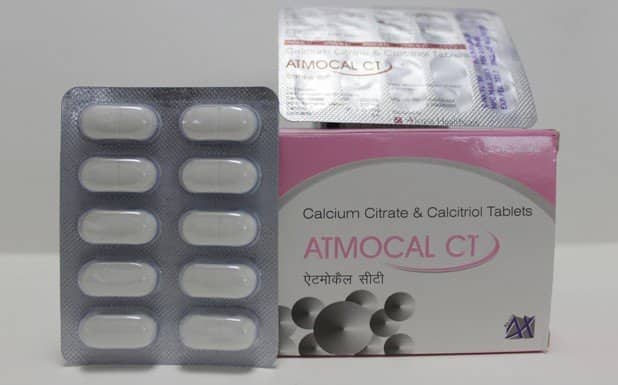
Composition
- Each Tablet Contains:
- Calcium citrate
Eq. to
elemental calcium 252 mg1200 mg - Calcitrol IP
0.25 mcg
Packing
- 1x10
(Blister)
MRP
- 65
Overview
This medication is a combination of Calcium and Calcitriol in which calcium plays a very important role in the body. It is necessary for normal functioning of nerves, cells, muscle, and bone. If there is not enough calcium in the blood, then the body will take calcium from bones, thereby weakening bones. Vitamin D helps your body absorb calcium and phosphorus. Calcium is necessary for many normal functions of our body, especially bone formation and maintenance. Calcium also binds to other minerals (such as phosphate) and aid in their removal from the body. Calcitriol helps in the control of some conditions that arise because of fluctuating levels of the parathyroid hormone in the body.
Indications
- To prevent or treat low blood calcium levels.
- Osteoporosis
- Osteomalacia
- Rickets
- Hyperparathyroidism
Dosage
Oral:
Tablet may be taken with or without food.
Disclaimer:To be taken only after consulting with the doctor.
For Professionals
Pharmacodynamics Properties of Calcium Citrate
Increases plasma calcium levels leading to a decrease in calcium flux and increase in calcium deposition into bone.
MECHANISM OF ACTION
Calcium citrate increases plasma calcium levels. This reduces calcium flux from osteocyte activity by reducing the secretion of parathyroid hormone (PTH)Ā[3]. Calcium does this by stimulating a G-protein coupled calcium receptor on the surface of parathyroid cells. The reduction in calcium flux increases the amount of calcium deposited in bone resulting in an increase in bone mineral density. The reduction in PTH secretion also reduces the amount of vitamin D metabolized to its active form, calcidiol. Since calcidiol increases the expression of calcium dependent ATPases and transient receptor potential cation channel subfamily V member 6 (TRPV6) both of which are involved in calcium uptake from the gut, a reduction in calcidiol results in less calcium absorption.
Pharmacokinetics Properties of Calcium Citrate
Absorption from the GI tract requires Vitamin D. Available elemental calcium depends on the salt form used, dose administered and the presence of an acid environment in the stomach. Elimination is primarily in the feces as unabsorbed calcium and the kidneys eliminate 20%.
Pharmacodynamics Properties of Calcitriol
Calcitriol is a synthetic vitamin D analog which is active in the regulation of the absorption of calcium from the GIT and its utilization in the body.
MECHANISM OF ACTION
Calcitriol is a 1, 25-dihydroxycholecalciferol or a Vitamin D analogue. It increases the absorption of Calcium from intestine by forming a calcium binding protein. It reverses the signs of rickets and osteomalacia.
Pharmacokinetics Properties of Calcium Citrate
Absorption: It is readily absorbed after oral administration.
Distribution: It is widely distributed in protein bound form.
Metabolism: It undergoes metabolism in the liver and kidney.
Excretion: It is excreted mainly in the faces.
Side Effects
Very rare but common side effects are:
- Nausea or vomiting
- Decreased appetite;
- Constipation;
- Dry mouth or increased thirst; or
- Increased urination